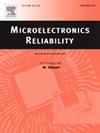Experimental and numerical analysis of cyclic ratchetting and low cycle fatigue behaviour in meander-shaped interconnects for stretchable electronics applications
IF 1.6
4区 工程技术
Q3 ENGINEERING, ELECTRICAL & ELECTRONIC
引用次数: 0
Abstract
Stretchable interconnect is a crucial component of a wearable device, responsible for establishing electrical connections throughout the system. Among various technologies, thin film-based interconnects provide superior electrical conductivity comparable to bulk metals, enabling high-quality signals in diverse wearable applications. Nevertheless, their relatively low mechanical fatigue life remains a significant challenge. Research has shown that flexible polymer-supported interconnects exhibit improved fatigue life compared to non-supported counterparts.
Albeit widespread adoption of thin film-based stretchable tracks, underlying physical principles governing their fatigue life is not thoroughly studied. In this work, stretchable interconnects are fabricated and analysed using a cost-effective method suitable for mass fabrication. This study focuses on modelling of the stretchable interconnects using FEM under both static and dynamic loadings to discover the significant role of flexible polymer in increasing the cyclic fatigue life. Polyimide (PI)-supported interconnects show a major decrease (~ 20 %) in maximum strain under static load compared to non-supported interconnects. It has been demonstrated that under dynamic loading, non-supported interconnects fail mostly based on ratcheting strain, whereas low cycle fatigue (LCF) governs the failure mechanism of PI supported tracks. The latter happens due to the beneficial residual stress imposed by the flexible support layer. The findings are supported by characterizing the experimentally fabricated stretchable interconnects.
用于可拉伸电子应用的曲线形互连中循环棘轮和低周疲劳行为的实验和数值分析
可拉伸互连是可穿戴设备的重要组成部分,负责在整个系统中建立电气连接。在各种技术中,基于薄膜的互连提供了与大块金属相当的优越导电性,在各种可穿戴应用中实现了高质量的信号。然而,它们相对较低的机械疲劳寿命仍然是一个重大挑战。研究表明,柔性聚合物支撑的互连与非支撑的互连相比,具有更高的疲劳寿命。尽管薄膜可拉伸轨道被广泛采用,但控制其疲劳寿命的基本物理原理尚未得到深入研究。在这项工作中,使用一种适合批量制造的经济有效的方法制造和分析了可拉伸互连。本研究主要是利用有限元方法对静态和动态载荷下的可拉伸连接件进行建模,以发现柔性聚合物对提高循环疲劳寿命的重要作用。与非支持的互连相比,支持聚酰亚胺(PI)的互连在静态载荷下的最大应变显著降低(~ 20%)。研究表明,在动载荷作用下,非支撑互联的失效主要是棘轮应变,而低周疲劳(LCF)主导着PI支撑轨道的失效机制。后者是由于柔性支撑层施加的有益残余应力而发生的。实验制备的可拉伸互连的特性支持了这些发现。
本文章由计算机程序翻译,如有差异,请以英文原文为准。
求助全文
约1分钟内获得全文
求助全文
来源期刊

Microelectronics Reliability
工程技术-工程:电子与电气
CiteScore
3.30
自引率
12.50%
发文量
342
审稿时长
68 days
期刊介绍:
Microelectronics Reliability, is dedicated to disseminating the latest research results and related information on the reliability of microelectronic devices, circuits and systems, from materials, process and manufacturing, to design, testing and operation. The coverage of the journal includes the following topics: measurement, understanding and analysis; evaluation and prediction; modelling and simulation; methodologies and mitigation. Papers which combine reliability with other important areas of microelectronics engineering, such as design, fabrication, integration, testing, and field operation will also be welcome, and practical papers reporting case studies in the field and specific application domains are particularly encouraged.
Most accepted papers will be published as Research Papers, describing significant advances and completed work. Papers reviewing important developing topics of general interest may be accepted for publication as Review Papers. Urgent communications of a more preliminary nature and short reports on completed practical work of current interest may be considered for publication as Research Notes. All contributions are subject to peer review by leading experts in the field.
 求助内容:
求助内容: 应助结果提醒方式:
应助结果提醒方式:


